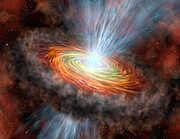Heavyweights vs. Lightweights: Are the Largest Stars Born Like our Sun?
27 January 2010
Explaining how the most massive stars are born, deep within their stellar nurseries, is one of the most persistent mysteries in modern astronomy. Now, observations at the Gemini Observatory provide convincing new evidence that these stellar heavyweights may be born in much the same manner as lightweights like our Sun.
“The problem is that when the most massive stars form it happens very quickly compared to stars like our Sun, and by the time they break free of their natal clouds they are already the finished article,” said Ben Davies of the University of Leeds (UK) and the Rochester Institute of Technology. “If you want to see a massive star in the process of forming, you need to be able to see through the obscuring clouds to where the action is.”
Davies led an international team of researchers who brought infrared sensitivity and the extreme resolution of adaptive optics to bear on the problem. This allowed the team to penetrate the obscuring gas and dust clouds surrounding the massive proto-star W33A. What they found was “… reassuringly familiar, like a nice cup of tea. This is exactly the sort of kinematic evidence we have been looking for,” said team member Melvin Hoare, also of the University of Leeds.
Davies’ team calculates that the prenatal star is at least 10 times more massive than our Sun, and is still rapidly growing. According to Davies, this is the first time we’ve been able to unravel the dynamics deep inside a heavyweight stellar nursery at this level of detail. “We’ve caught a massive star in the act of formation, and found signatures of an accretion disk embedded within a torus of gas and dust. We also see material being blasted away from the poles at speeds of up to 300 kilometers per second. These features are all common to the formation process found in much smaller stars."
The massive star forming inside of W33A is completely obscured in optical light (as seen by the human eye) but, as Davies explains, “…while the optical light is attenuated by about a factor of 10,000, much of the infrared light can pass through the intervening material. This affords us a glimpse of what is happening deep inside W33A's natal cloud.”
Several conflicting theories strive to explain how massive stars are born, whether it is a scaled-up version of low-mass star formation, or whether a completely different physical process is involved. Now, observations with adaptive optics and infrared spectroscopy are catching massive stars 'in the act' of forming.
Davies’ team utilized the power of adaptive optics to remove atmospheric blurring and then dissected the light using the Near-Infrared Integral Field Spectrograph (NIFS) on the Frederick C. Gillett Gemini North telescope on Hawaii’s Mauna Kea. NIFS creates what is sometimes called a spectral image consisting of about 2,000 individual spectra in a square array that covered the heart of W33A. These data are assembled into a “datacube” which allow the scientists to look at individual features of the spectra at each point and assemble a multi-dimensional image of the environment around the birthing star. “We were not only able to resolve the inner nebula on small spatial scales, but also probe its dynamics by measuring the Doppler-shift of light from the glowing gas to determine its velocity and how it flows around the forming star,” said Davies. “This is an amazingly powerful tool for understanding the inner workings of how stars actually form.”
Known as a Massive Young Stellar Object (MYSO), W33A is located about 12,000 light years away, toward the constellation of Sagittarius. Previous studies of this object only hinted at its dynamic nature but until now no MYSO’s have been studied at this level of detail using the combination of adaptive optics and integral field spectroscopy utilized by the Davies team.
Colin Aspin of the Institute for Astronomy at the University of Hawai‘i adds, “This result provides us with one of the first clues that high-mass stars form in similar ways to their low-mass counterparts and shows the power of integral-field near-infrared spectroscopy as a way of probing the youngest phases of stellar evolution.”
Notes
The team’s accepted paper is pending publication in the Monthly Notices of the Royal Astronomical Society.
Links
- A recent result from the Subaru Observatory, also on Mauna Kea, provides additional evidence for this process in massive stars with the first direct image of a circumstellar disk around a young massive star. See: https://www.naoj.org/old/Pressrelease/2009/11/18/index.html
Contacts
Ben Davies
University of Leeds (UK)/Rochester Institute of Technology (US)
Tel: (+44) 113 343 8279
Cell: (+44) 778 685 2324
Email: b.davies@leeds.ac.uk
Peter Michaud
Gemini Observatory
Hilo, HI 96720
Tel: 1 (808) 974-2510
Cell: 1(808) 936-6643
Email: pmichaud@gemini.edu
About the Release
| Release No.: | gemini1003 |
| Name: | W33A |
| Facility: | Gemini North |
| Instruments: | ALTAIR, NIFS |
| Science data: | 2010MNRAS.402.1504D |


